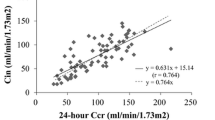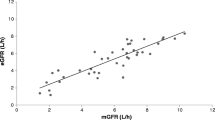Abstract
We investigated the influence of the type rather than the degree of renal insufficiency on the renal clearance of drugs. Different models of site specific experimental renal failure (ERF) have been developed in the rat; proximal tubular necrosis, induced by cisplatin; papillary necrosis, induced by 2-bromoethylamine, and glomerulonephritis, induced by sodium aurothiomalate or by antiglomerular basement membrane antibody. Several parameters of kidney function were assessed: the clearance of inulin, PAH, and endogenous N-1-methylnicotinamide (NMN). Plasma BUN and creatinine concentrations, and the presence of proteinuria and glucosuria were also measured. Our results showed a nonparallel decrease in glomerular filtration rate (GFR)and tubular secretion as measured by the secretory clearance of endogenous NMN or by the secretory clearance of p-aminohippuric acid (PAH), that is incompatible with the “intact nephron hypothesis.” As a result, the renal clearance of cimetidine, a drug eliminated mainly by renal secretion, correlated better with the renal clearance of endogenous NMN than with the GFR.We conclude that (i) our models of ERF demonstrated the existence of glomerulo-tubular imbalance that is contrary to expectations based on the intact nephron hypothesis; (iii) the type of the renal disease has a direct influence on the renal clearance of cimetidine; (in) the clearance of endogenous NMN may be a valuable noninvasive test for assessing renal tubular secretion which could be useful in predicting the clearance of drugs eliminated predominantly by tubular secretion.
Similar content being viewed by others
References
J. Wartak. A modem approach in individualised drug therapy. In J. Wartak (eds.),Clinical Pharmacokinetics, Praeger, New York, 1983, pp. 175–189.
J. Fabre and L. Balant. Drug pharmacokinetics and action in renal failure. In M. Gibaldi and L. Prescott (eds.),Handbook of Clinical Pharmacokinetics, Vol. 1, Adis, Hong Kong, 1983, pp. 212–234.
L. Dettli. Drug dosage in renal failure.Clin. Pharmacokin. 1:126–134 (1976).
L. Dettii. Drug dosage in renal failure. In M. Gibaldi and L. Prescott (eds.),Handbook of Clincal Pharmacokinetics, Vol. 1, Adis, Hong Kong, 1983, pp. 261–276.
T. D. Bjornsson. Use of serum creatinine concentration to determine renal function.Clin. Pharmacokin. 4:200–222 (1979).
N. S. Bricker, P. A. F. Morrin, and S. W. Kime. The pathologic physiology of chronic Bright's disease.Am. J. Med. 28:77–98 (1960).
N. S. Bricker, R. Klahr, H. Lubowitz, and R. E. Rieselbach. The pathologic physiology of chronic Bright's disease.Medicine 44:263–288 (1965).
T. U. L. Biber, M. Mylle, and C. W. Gottschalk, Micropuncture study of kidney function in rats with experimental tubular necrosis. In J. Vostal and G. Richet (eds.),Second International Congress of Nephrology, Vol. 1, Prague, 1964, pp. 21–27.
T. U. L. Biber, M. Mylle, A. D. Baines, C. W. Gottschalk, and M. C. McDowell. A study of micropuncture and microdissection of acute renal damage in rats.Am. J. Med. 44:664–705 (1968).
M. M. Reidenberg, M. Camacho, J. Kluger, and D. E. Drayer. Ageing and renal clerance of procainamide and acetylprocainamide.Clin. Pharmacol Ther. 28:732–735 (1980).
P. T. Daley-Yates and D. C. H. McBrien. Cisplatin (cis dichlorodiammine platinum II) nephrotoxicity. In P. H. Bach, F. W. Bonner, J. W. Bridges, and E. A. Lock (eds.),Nephrotoxicity, Assessment and Pathogenesis, Wiley, Chichester, 1982, pp. 356–370.
D. C. Dobyan, J. Levi, C. Jacobs, J. Kosek, and M. W. Weiner. Mechanism of cis-platinum nephrotoxicity: II. Morphologic observations.J. Pharmacol. Exp. Ther. 213:551–556 (1980).
G. S. Hill, R. G. Willye, M. Miller, and R. M. Heptinstall. Experimental papillary necrosis of the kidney.Am. J. Pathol. 68:213–234 (1972).
R. Vanholder, N. Lameire, W. Eeckhaut, and S. Ringoir. Renal function studies in an experimental model of papillary necrosis in rat.Arch. Int. Physiol. Biochem. 89:63–73 (1981).
A. H. Nagi, F. Alexander, and A. Z. Barabas. Gold nephropathy in rats—light and electron-microscopic studies.Exp. Mol. Pathol. 15:354–362 (1971).
T. S. Edgington, R. J. Glassock, J. A. Watson, and F. J. Dixon. Characterization and isolation of specific renal tubular epithelial antigens.J. Immunol. 99:1199–1210 (1967).
D. C. Cattran and W. B. Chodirker. Experimental membranous glomerulonephritis.Nephron 31:260–265 (1982).
S. O. Stitzer and M. Martinez-Maldonado, Clearance methods in the rat. In M. Martinez-Maldonado (ed.),Methods in Pharmacology, Vol. 4B, Pleum Press, New York, 1978, pp. 23–40.
R. A. Kramp, M. McDowell, C. W. Gottschalk, and J. R. Oliver. A study by microdissection and micropuncture of the structure and the function of the kidneys and the nephrons of rats with chronic renal damage.Kidney Int. 5:147–176 (1974).
L. D. Griffith, R. E. Bulger, and B. F. Trump. The ultrastructure of the functioning kidney.Lab. Invest. 16:220–246 (1967).
A. Adedoyin, L. Aarons, and J. B. Houston. High-performance liquid chromatographic method for the simultaneous determination of cimetidine and antipyrine in plasma.J. Chromatog. 345:192–196 (1985).
R. Greger, F. Lang, F. G. Knox, and C. Lechene. Analysis of tubule fluid. In M. Martinez-Maldonado (ed.),Methods in Pharmacology, Vol. 4B, Plenum Press, New York, 1978, pp. 105–140.
B. R. Clark, R. M. Halpern, and R. A. Smith. A fluorimetric method for quantitation in the picomole range ofN-1-methylnicotinamide and nicotinamide in serum.Anal. Biochem. 68:54–61 (1975).
C. K. Shim, Y. Sawada, T. Iga, and M. Hanano. Estimation of renal blood flow by use of endogenousN-1-methylnicotinamide in rats.J. Pharmacobiodyn. 8:20–24 (1985).
C. Bratton and E. K. Marshall. A new coupling agent for sulfanilamide determination.J. Biol. Chem. 128:537–539 (1939).
J. L. McNay, S. Rosello, and P. G. Dayton. Effects of azotemia on renal extraction and clearance of PAH and TEA.Am. J. Physiol. 230:901–906 (1976).
C. K. Shim, Y. Sawada, T. Iga, and M. Hanano. Effect of experimental renal failure on intrinsic renal tubular secretory clearance of organic cations in rats.J. Pharmacobiodyn. 6:787–789 (1983).
A. Maïza and P. T. Daley-Yates. The clearance of drugs in different types of renal disease.Renal Failure 11:67 (1988).
A. Maïza and P. T. Daley-Yates. Drug pharmacokinetics in renal failure: Influence of disease type. In P. H. Bach and E. A. Lock (eds.),Nephrotoxicity: Extrapolation from In Vitro in In Vivo and from Animals to Man, Plenum Press, London, 1989, pp. 381–386.
J. Oliver.Architecture of the Kidney in Chronic Bright's Disease, Hoeber, New York, 1939.
M. E. M. Allison, C. B. Wilson, and C. W. Gottschalk. Pathophysiology of experimental glomerulonephritis in rats.J. Clin. Invest. 53:1402–1423 (1974).
A. Rocha, M. Marcondes, and G. Malnic. Micropuncture study in rats with experimental glomerulonephritis.Kidney Int. 3:14–23 (1973).
J. H. Lin, A. N. Chremos, K. C. Yeh, J. Antonello, and G. A. Hessey. Effects of age and chronic renal failure on the urinary excretion kinetics of famotidine in man.Eur. J. Clin. Pharamacol. 34:41–46 (1988).
P. G. Welling, W. A. Craig, and C. M. Kunin. Prediction of drug dosage in patients with renal failure using data derived from normal subjects.Clin. Pharmacol. Ther. 18:45–52 (1975).
M. Weiner and L. Roth. Renal excretion of cimetidine.J. Pharmacol. Exp. Ther. 216:516–520 (1981).
J. H. Lin and T. H. Lin. Renal handling of drugs in renal failure. I: Differential effects of uranyl nitrate- and glycerol-induced acute renal failure on renal excretion of TEA and PAH in rats.J. Pharmacol. Exp. Ther. 246:896–901 (1988).
C. A. Gloff and L. Z. Benet. Differential effects of the degree of renal damage on p-aminohippuric acid and inulin clearances in rats.J. Pharmacokin. Biopharm. 17:169–177 (1989).
R. Larsson, B. Norlander, G. Bodemar, and A. Walan. Steady-state kinetics and dosage requirements of cimetidine in renal failure.Clin. Pharmacokin. 6:316–326 (1981).
T. R. Vickery. Cimetidine reaction.Drug Intell. Clin. Pharm. 12:242–244 (1978).
J. B. Spears. Cimetidine and mental confusion.Am. J. Hosp. Pharm. 35:1035 (1978).
C. A. Wood, M. L. Isaacson and M. S. Hibbs. Cimetidine and mental confusion.J. Am. Med. Assoc. 239:2550–2551 (1978).
W. E. Knox and W. I. Grossman. A new metabolite of nicotinamide.J. Biol. Chem. 166:391–392 (1946).
K. H. Beyer, H. F. Russo, S. R. Gass, K. S. Wilhoyte, and A. A. Pitt. Renal tubular elimination ofN-1-methylnicotinamide.Am. J. Physiol. 160:34–37 (1950).
C. R. Ross, F. Diezi-Chomety, and F. Roch-Ramel. Renal excretion ofN-methyl-nicotinamide in rat.Am. J. Physiol. 228:F1641-F1645 (1975).
C. K. Shim, Y. Sawada, T. Iga, and M. Hanano. Estimation of renal secretory function for organic cations by endogenous N-1-methylnicotinamide in rats with experimental renal failure.J. Pharmacokin. Biopharm. 12:23–42 (1984).
Author information
Authors and Affiliations
Rights and permissions
About this article
Cite this article
Maiza, A., Daley-Yates, P.T. Prediction of the renal clearance of cimetidine using endogenousN-1-methylnicotinamide. Journal of Pharmacokinetics and Biopharmaceutics 19, 175–188 (1991). https://doi.org/10.1007/BF01073868
Received:
Revised:
Published:
Issue Date:
DOI: https://doi.org/10.1007/BF01073868




